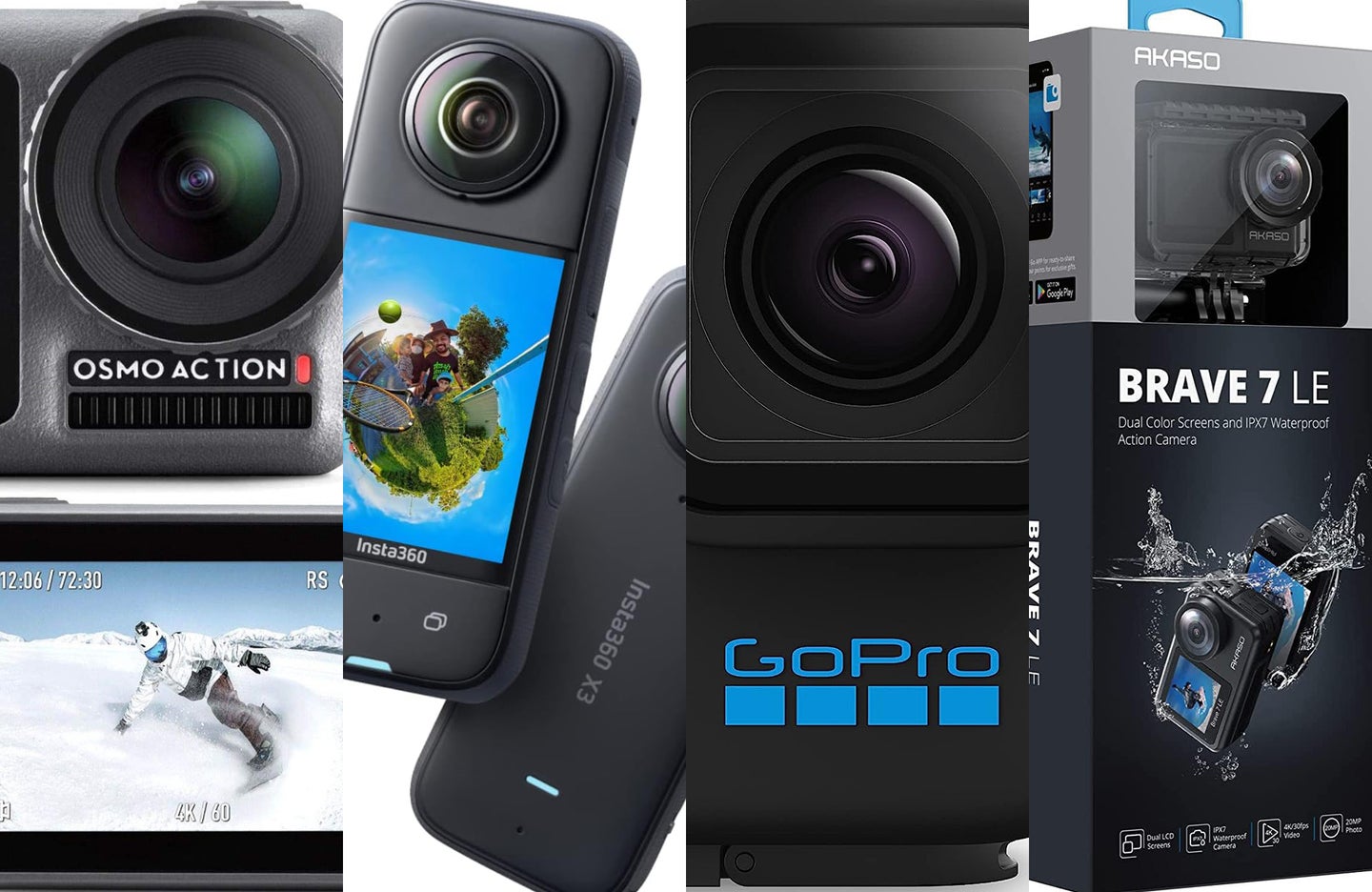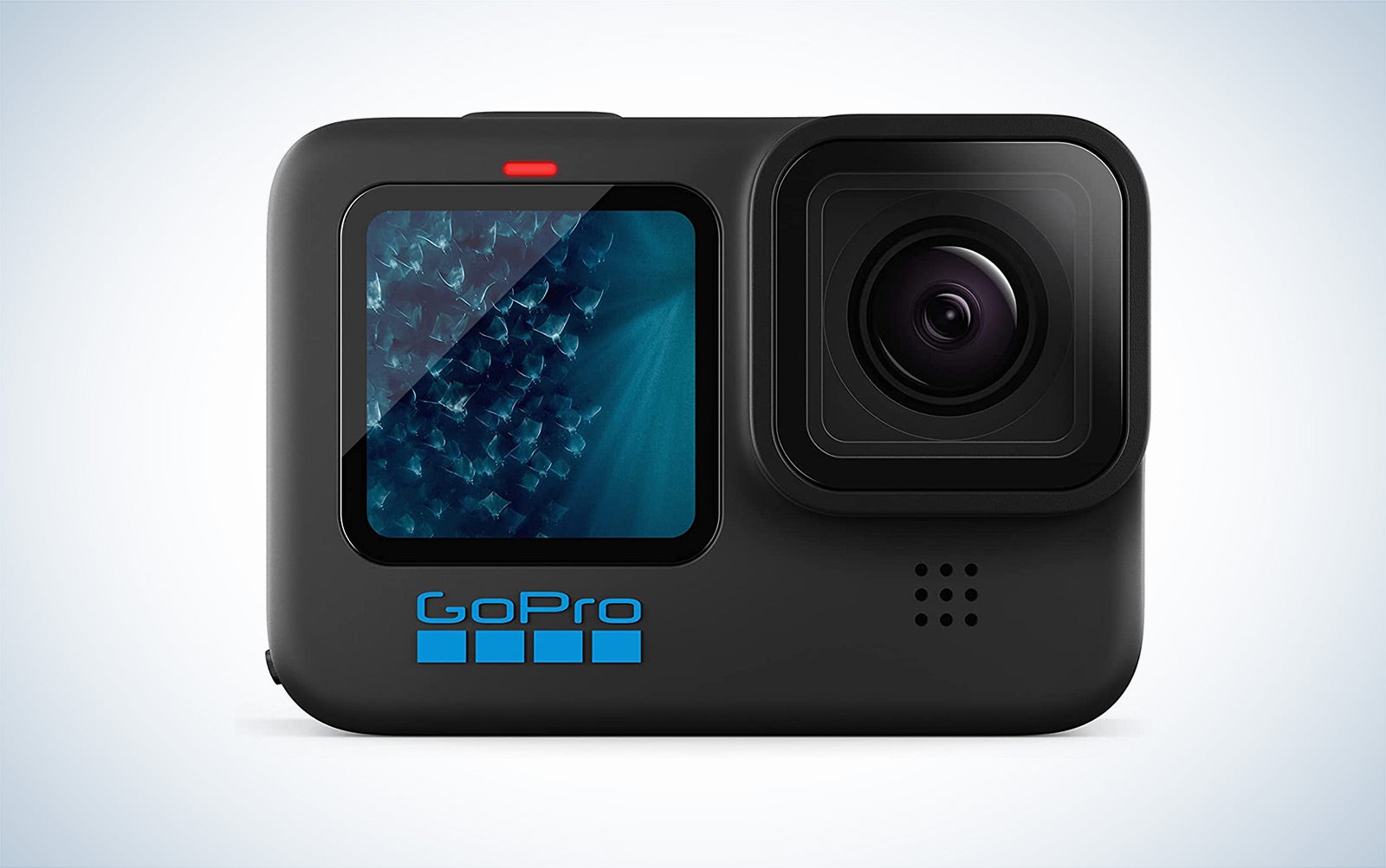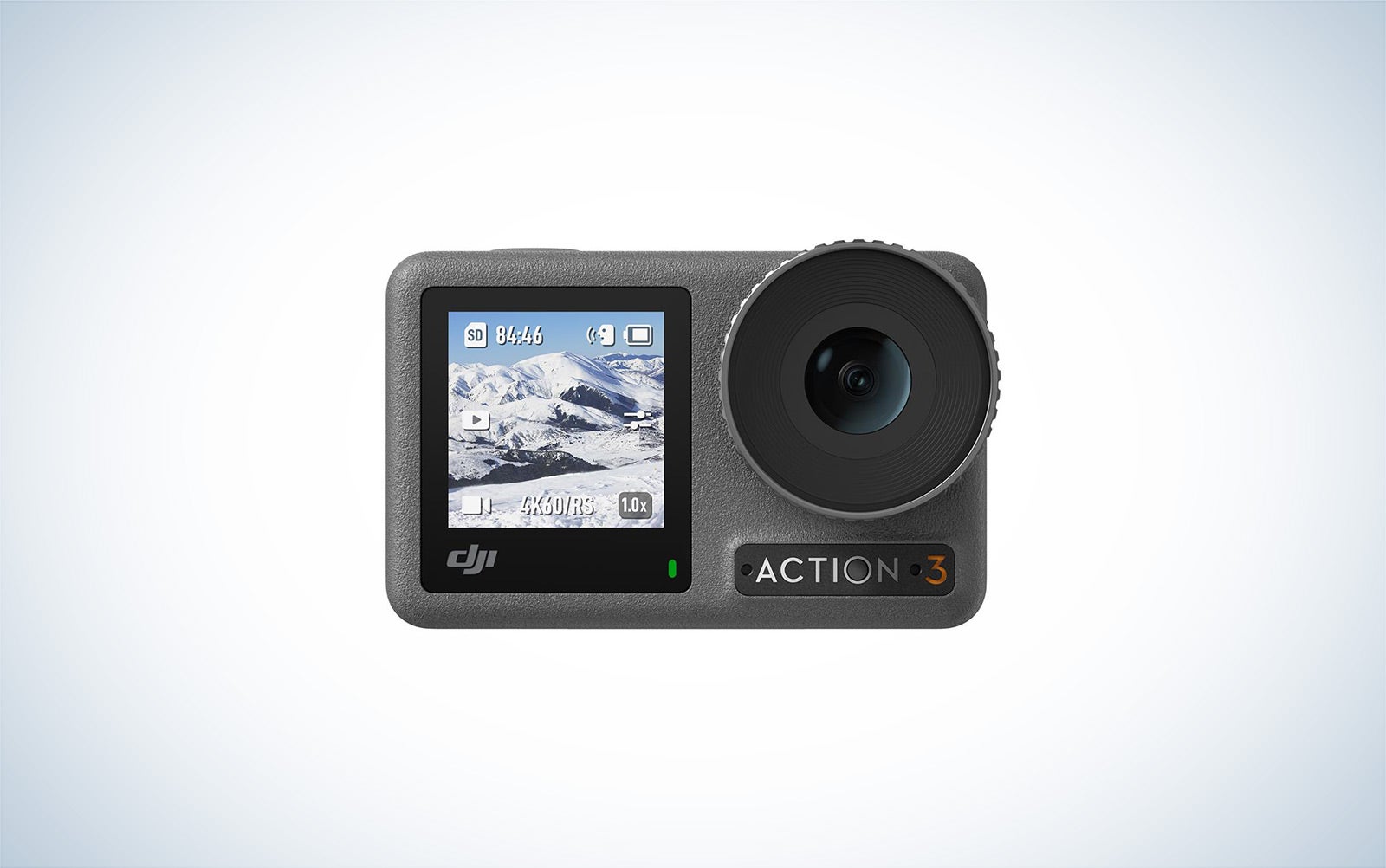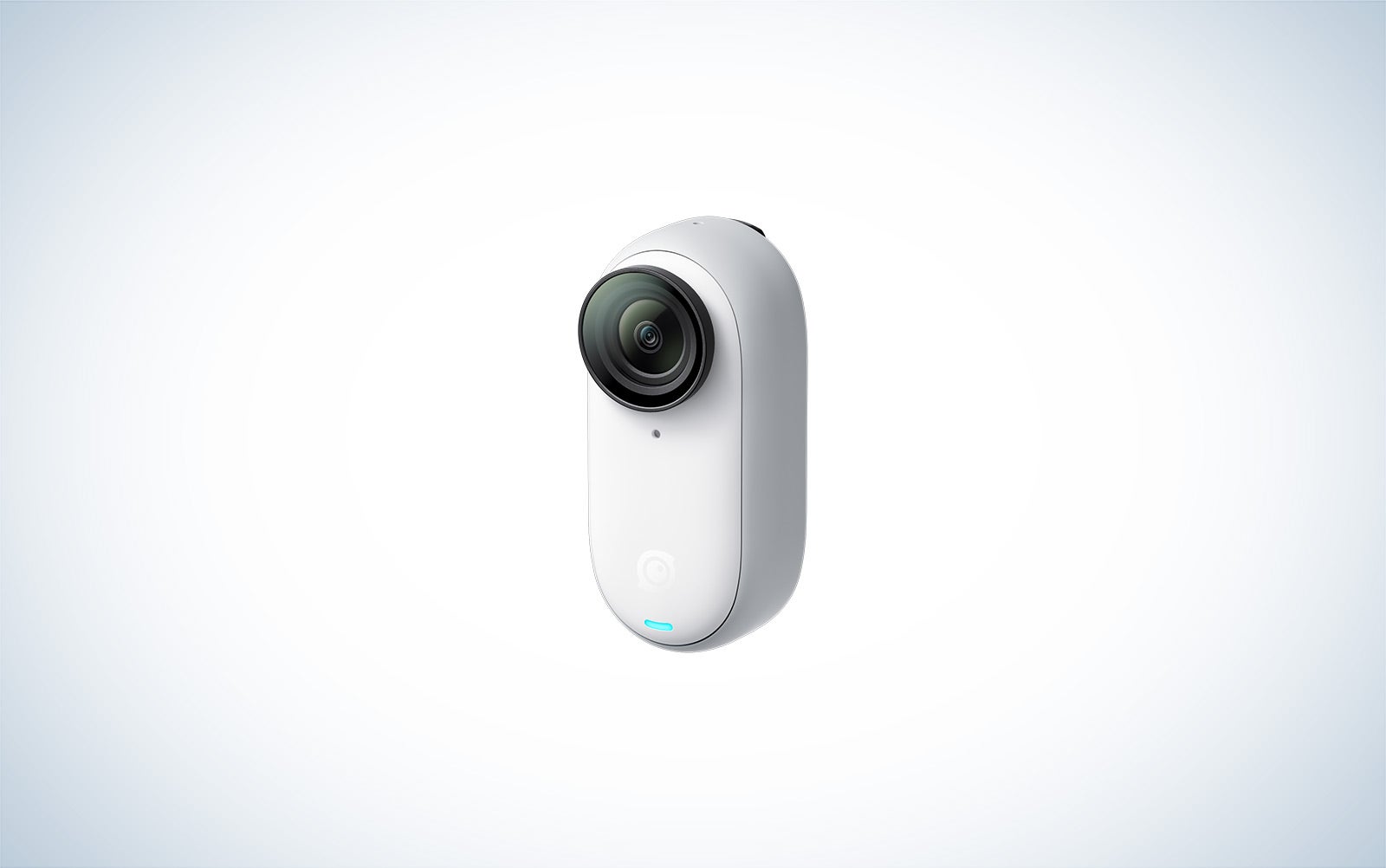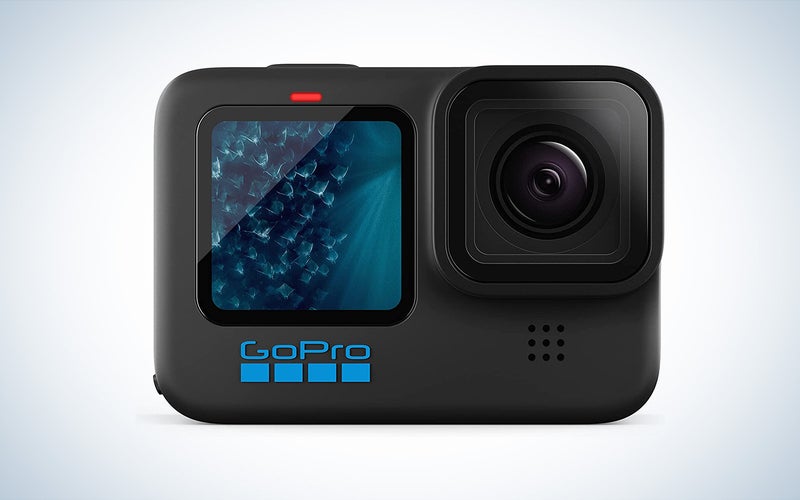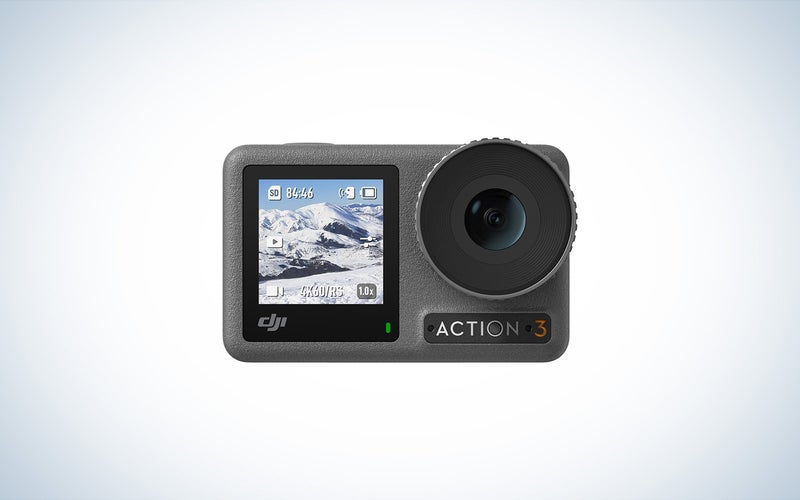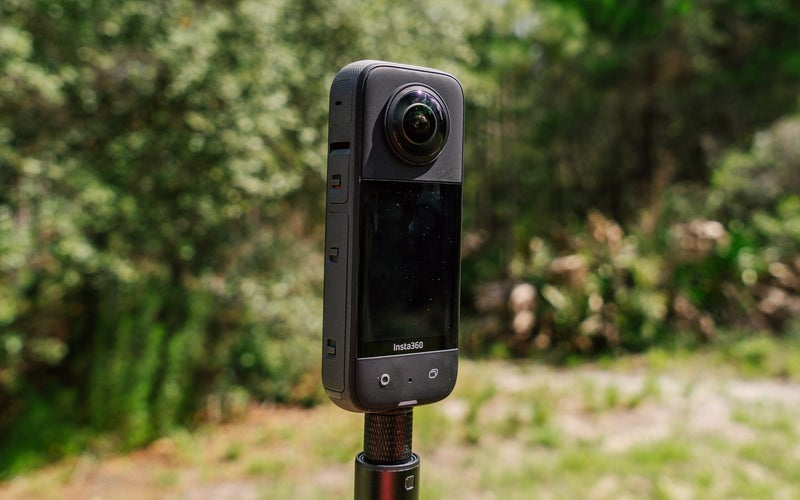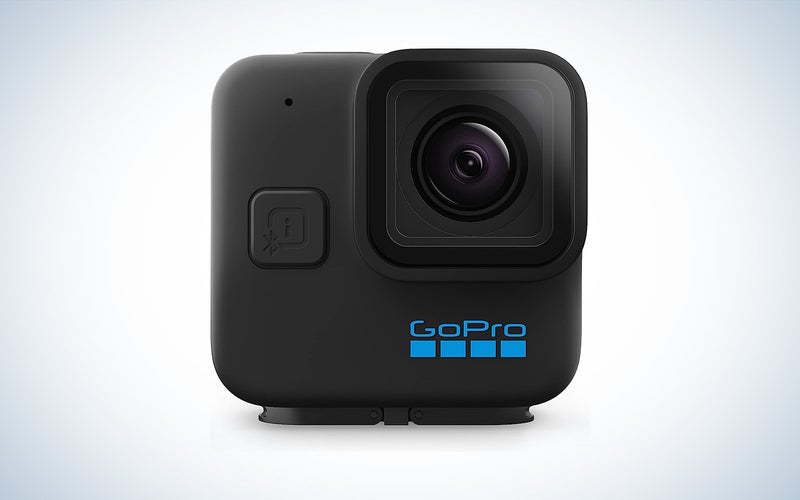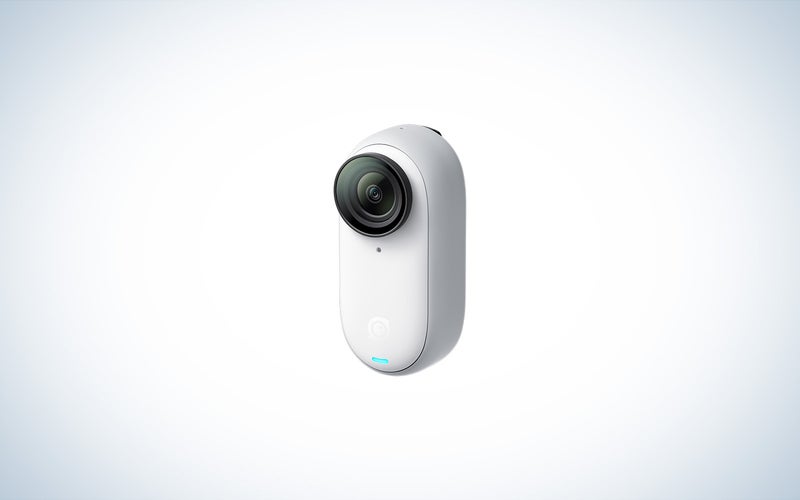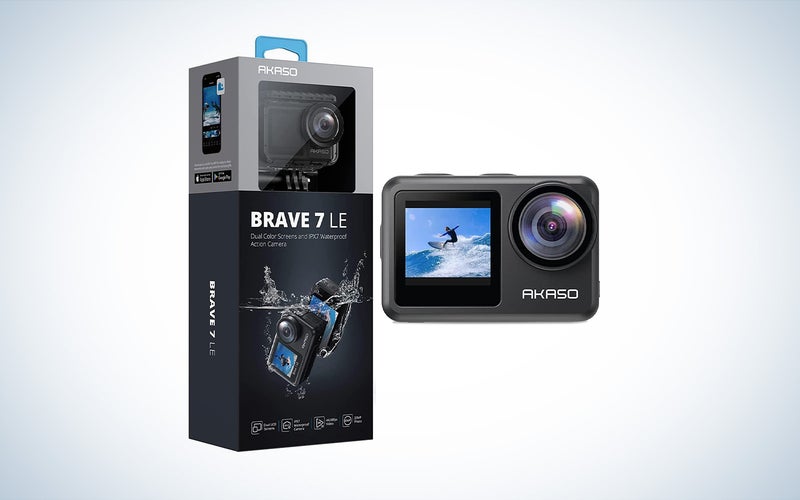We may earn revenue from the products available on this page and participate in affiliate programs. Learn more ›
Action cameras are a high-speed ticket to capturing the most immersive and engaging footage possible. They bring viewers as close to your experiences as they can be without actually being there. These video cameras excel in environments where stability and durability are key to attaining the highest caliber of footage, which is why they are popular amongst surfers, bikers, climbers, and other athletes. Plus, vloggers, video production teams, and hobbyists of all kinds can benefit from the compact and easy-to-handle design. From travel photography to underwater photography, the best action cameras provide a totally unparalleled video production experience to users of every interest and passion.
- Best overall: GoPro Hero 11 Black
- Best for vlogging: DJI Osmo Action 3
- Best for 360-degree video: Insta360 X3
- Best small: GoPro Hero 11 Black Mini
- Best for beginners: Insta360 GO 3
- Best budget: AKASO Brave 7 LE
How we chose the best action cameras
The writers and editors at PopPhoto have decades of experience with just about every camera brand and genre out there, including action cameras. As an adventure-lover and active individual, I have found myself in my fair share of situations ideal for action cameras. We chose the cameras included here through a mix of hands-on experience, user and editorial reviews, and brand knowledge.
When selecting the best action cameras, we focused on a variety of features and specifications. They should foremost be compact and offer easy mounting solutions, making them easy to use without obstructing the action. Action cameras should also be durable and able to withstand epic adventures, including water trips. Lastly, we looked at video and photo quality, stabilization, and other camera-specific features.
Best action cameras: Reviews and recommendations
Whether you are climbing, mountain biking, surfing, or simply wanting to document your travels, these action cameras will help you capture your best (or sometimes worst) moments.
Best overall: GoPro Hero 11 Black
GoPro
Specs
- Max video resolution: 5.3K at 60 fps
- Max framerate: 240 fps at 2.7K
- Photo resolution: 27 megapixels
- Waterproofing: 33 feet
- Dimensions: 2.8 x 2 x 1.3 inches
- Weight: 4.5 ounces
Pros
- Improved photo performance
- New night modes add versatility
- Award-winning stabilization
- Vertical video support
Cons
- Battery won’t last all day
The GoPro Hero 11 Black is among the most well-known models of action cameras thanks to its durable and full-featured reputation. This latest model features the largest sensor in a GoPro yet. The large sensor makes it possible to crop video to vertical orientation without losing out on most of the scene, so you can share your epic adventures on social media. And it allows you to change digital lenses for different perspectives.
The Hero 11 results in stunning 5.3K video recording at up to 60 fps. Or, you can get up to 240 fps at 2.7k if you want dramatic slow-motion. Still photo quality has improved significantly over previous models, bumping up to 27-megapixel photos. You’ll have access to time-lapse and new night modes, including star trails and light painting.
As we would expect from a GoPro, the Hero 11 features incredibly impressive stabilization via HyperSmooth 5.0. Even videos of the most rugged activities will be smooth. It’s waterproof to 33 feet without a case, and GoPro built it with improved cold weather performance, so you can use it for your capturing your winter sports. The Hero 11 is a well-rounded, impressive action camera ready for anything you throw at it.
Best for vlogging: DJI Osmo Action
DJI
Specs
- Max video resolution: 4K at 120 fps
- Max framerate: 240 fps at 1080p
- Photo resolution: 12 megapixels
- Waterproofing: 52 feet
- Dimensions: 2.8 x 1.7 x 1.3 inches
- Weight: 5.1 ounces
Pros
- More affordable than GoPro
- Waterproof down to 52 feet
- Front and rear touchscreen
- High-capacity battery for long recording sessions
Cons
- Video quality tops out at 4K
- Limited photo quality
DJI completely redesigned the third iteration of this action camera, and it is ready for seriously epic adventures. It’s waterproof down to 52 feet without special housing and features a color temperature sensor to automatically adjust the color of your video even if you are deep below the surface while scuba diving. Should you want to go even deeper, with a waterproof case, the camera can go to 210 feet.
For activities on land, the camera can function as cold as -4 degrees Fahrenheit. You’ll be able to document even your freezing-cold ski trips. It utilizes a unique magnetic quick-release plate that is convenient and easy to use. And you can mount the camera vertically, meaning no cropping is required in order to create social-media-ready video. And for vloggers, the live stream support at multiple resolutions is a huge benefit.
The DJI Osmo Action 3 is capable of image-stabilized 4K video up to 120 fps. DJI claims that there are no recording limits other than the promised 160-minute battery life when recording 4K 60p video, so long, single takes are possible. It offers the equivalent of a 12.5mm full-frame lens, so you can catch all of the action. The RockSteady stabilization does a great job of smoothing out video. And the HorizonSteady mode keeps your shots level and adjusts for any horizontal rotation. Unfortunately, photo resolution is limited to 12 megapixels, but if your focus is vlogging, that likely won’t matter as much anyway.
Best for 360-degree video: Insta360 X3
Abby Ferguson
Specs
- Max video resolution: 5.7K 360-degree, 4K single-lens
- Max framerate: 60 fps at 4K
- Photo resolution: 72-megapixel 360-degree, 18-megapixel single-lens
- Waterproofing: 33 feet
- Dimensions: 4.5 x 1.8 x 1.3 inches
- Weight: 6.3 ounces
Pros
- Impressive stabilization
- 360-degree video is highly immersive
- Lots of editing options
- Excellent photo and video quality
Cons
- App is a little confusing to use
If you want truly immersive videos of your action adventures, you can’t beat the Insta360 X3. This camera can record 360-degree video at up to 5.7K and 30 fps. Then, you can use either the Insta360 mobile or desktop apps to edit your video and reframe your shots how you want to showcase the best parts of each moment or show off the full 360-degree view at once.
This action camera is highly versatile, thanks to the ability to use a single lens along with the dual lenses used for recording 360-degree video. You can either record selfie content with the rear lens or show off what’s in front of you with the front-facing lens. And it features a handful of shooting modes, such as up to 8K 360-degree timelapse and 4K slow-motion. The 2.29-inch touchscreen makes it easy to adjust settings and see what you are recording.
The X3 is a durable camera and is waterproof down to 33 feet without a separate housing. It features a 6-axis gyroscope and uses Insta360’s FlowState stabilization for smooth video, even with activities like mountain biking. And the Horizon Lock mode keeps the shot level even as you move and rotate.
Best small: GoPro Hero 11 Black Mini
GoPro
Specs
- Max video resolution: 5.3K at 60 fps
- Max framerate: 240 fps at 2.7K
- Photo resolution: 24.7 megapixels
- Waterproofing: 33 feet
- Dimensions: 2.1 x 2 x 1.5 inches
- Weight: 4.7 ounces
Pros
- Tiny form factor is less intrusive
- Award-winning stabilization
- Excellent video quality
- Two mounting points
Cons
- No display for framing
- No dedicated photo mode
For those who are extra concerned about wind resistance and drag, the GoPro Hero 11 Black Mini is the way to go. This camera is 13 percent smaller than the Hero 11 Black, making it more suitable for mounting on a motorcycle helmet, surfboard, or airplane. It also features mounting feet on the bottom and back of the camera, opening up more options for how you mount it.
Despite the smaller size, the Hero 11 Mini gets many of the same features and specs as its big brother. It uses the same larger sensor allowing for vertical videos and is still capable of 5.3K 60p video with class-leading stabilization. Unfortunately, there is no photo mode on the Mini version. Instead, you’ll have to rely on grabbing 24-megapixel stills from videos.
Another difference between the Mini and regular-sized Hero 11 is the lack of a screen on the Mini. That means that you’ll need to reply on the Quik app for camera setup and framing help, but it’s one less thing to break on the camera, which is nice. It also features a built-in battery, so you won’t be able to swap batteries out when one dies. But GoPro promises 73 minutes of battery life when recording 5.3K 30p, which is plenty for most situations.
Best for beginners: Insta360 GO 3
Insta360
Specs
- Max video resolution: 2.7K at 30 fps
- Max framerate: 120 fps at 1080p
- Photo resolution: 6.6 megapixels
- Waterproofing: 16 feet
- Dimensions: 2.1 x 1 x 0.9 inches
- Weight: 1.3 ounces
Pros
- Stabilized video
- Unique magnetic mounting options
- Versatile modular design with the Action Pod
- Tiny size is very convenient
Cons
- Photos are only INSP or DNG
- Built-in memory is limiting
If the GoPro Hero 11 Mini isn’t small enough for you, the Insta360 GO 3 is the smallest that action cameras come. It weighs just 1.3 ounces, which is light enough to put on your hat and barely notice. The tiny size makes it feasible to put in locations that you otherwise couldn’t. This modular camera utilizes a unique magnetic mounting system that is fast and simple to use. And it comes with a few different mountain devices right in the box to get you started, including a magnet pendant and Easy Clip for wearing the camera on your person.
The GO 3 tops out at 2.7K 30p video, which is the main disadvantage of this camera. But, if you just want to capture memories or share your action adventures on social media, 2.7K is more than enough. And there are no recording limits at that resolution, so you can record long takes. It also allows for 120fps when backing off the resolution to 1080p, offering up slow-motion footage. And you’ll have access to Insta360’s impressive stabilization for smooth video.
This tiny action camera is waterproof to 16 feet on its own. It comes with the new Action Pod, which, although that adds bulk, it extends the battery life from 45 minutes to 170 minutes. It also adds a 2.2-inch flip touchscreen, which is very convenient and adds versatility to the camera. And it’s all very easy to use with simple controls and AI editing tools to take most of the work out of your hands.
Best budget: AKASO Brave 7 LE
Akaso
Specs
- Max video resolution: 4K at 30 fps
- Max framerate: 120 fps at 720p
- Photo resolution: 20 megapixels
- Waterproofing: IPX7, 131 feet with included case
- Dimensions: 2.44 x 1.61 x 1.26 inches
- Weight: 4.64 ounces
Pros
- Comes with waterproof housing
- Front and rear-facing screen
- Stabilization is fairly effective
- Affordable
Cons
- Photo and video quality are lacking
- Image stabilization results in heavy crop
Most action cameras are quite expensive and come with extensive lists of features. Not everyone needs the latest and greatest camera, though. If you just want a durable, basic action camera to document your travels, the AKASO Brave 7 LE is a great choice. The camera itself is IPX7 rated, but it comes with a case that makes it waterproof to 131 feet. The case also makes it more rugged and durable, allowing you to worry less about dings and falls.
The Brave 7 LE is capable of 4K 30p video or 720p at 120 fps for slow motion. It offers 6-axis electronic stabilization, which is pretty good considering the price of the camera. It does result in a significant crop in your footage, though. For still photos, it can take up to 20-megapixel images.
This budget action cam features a front and rear screen, which makes it easier to frame your shots no matter which way you point the camera. It comes with two batteries, a remote, waterproof housing, and multifunction mounting kits, so you have everything you need to get recording right away. And it supports a Wi-Fi connection making it easier to transfer your photos and videos.
Features to consider when shopping for the best action cameras
The best action camera for your needs will depend on the nature of the filming environment as well as your ultimate use of the footage. Considering the size, waterproofing, video quality, and budget is essential whether you’re traveling, vlogging, or just starting out on your action camera journey.
Stabilization
One of the most important aspects of any action camera is how effective its image stabilization is. Action sports typically result in jarring movements, which can make footage unwatchable if it isn’t stabilized effectively. That said, if you’re primarily using an action camera for casual use on your travels, you may be able to get away with less stabilization than others. And you can make some adjustments in editing if you would like. But, if you are a mountain biker, trail runner, or recording any type of activity with lots of movement, you will want to look for a camera with the best possible stabilization.
Mounting options
An action camera won’t do you much good if you can’t mount it in a way that enables you to actually record your activity without holding it. For example, you may want a way to mount the camera to a helmet or the end of a surfboard, which are two very different mounts. So, before purchasing a camera, be sure that the company makes a mount specifically for the activity you want to record.
Waterproofing and build-quality
Action cameras should be durable since they are meant to be used for, well, action. Most are ruggedly built and able to withstand lots of abuse. That said, depending on what type of sports or activities you plan on using the camera for, you may want to invest in more protection for the lens or camera as a whole. If so, be sure to check what accessories are available prior to purchasing.
For those who want to take their camera underwater, knowing the waterproofing is key. Most cameras these days are waterproof to fairly deep without any additional case. For example, the GoPro can be submerged down to 33 feet. But if you want to use the camera for scuba diving, you’ll need to invest in a case to take it deeper than that. We always recommend purchasing a waterproof housing directly from the company that made the camera to ensure proper fit, as you don’t want to risk the case flooding with water.
Photo and video quality
What photo and video quality you need from your action camera depends on how you intend to use the footage. If you are just wanting the camera to document your travels and adventures for the sake of memories or maybe to share on social media, you don’t necessarily need 4K video quality. But, if you want to create YouTube videos of your content, or maybe even have grander plans than that, then you will want to go with the highest quality possible.
Likewise, if you primarily want to record videos, you don’t necessarily need to pay attention to photo specs. But, if you want more flexibility, be sure to check what the camera can produce in terms of still photos as well.
Size
While all action cameras are compact, some are smaller than others. If you partake in sports or activities where drag and wind resistance are critical, such as surfing, motorcycle or automotive sports, or flying an airplane, the smaller the camera, the better. Smaller cameras also allow for more unique mounting opportunities, as they can be placed in locations that larger cameras could not. Of course, there are usually sacrifices with smaller cameras, including lower video and photo quality and shorter battery life. It’s simply a matter of deciding what is most important to you.
FAQs
Q: How do I choose an action camera?
Most models of action cameras include similar features across different brands, but the key factors to consider are the intended environment of use, the resolution required, and the desired weight and size of the camera. When in doubt, a 4K camera with a highly durable casing should fare well in a large majority of situations.
Q: What is the best alternative to a GoPro?
The DJI Osmo Action 3 is one of the best alternatives to a GoPro, thanks to its durable construction and mounting flexibility. This class of action camera is set apart by being compatible with a large range of proprietary accessories, which enables them to excel in almost any environment.
Q: Can action cameras be used for photography?
Yes. Action cameras are used for photography all the time—the high-megapixel sensors that help an action camera excel at capturing high-resolution video are the same that allow units to take high-quality still photos. Many units include such a photography mode by default but double-check before buying if it’s a must-have feature on your list.
Final thoughts on the best action cameras
- Best overall: GoPro Hero 11 Black
- Best for vlogging: DJI Osmo Action 3
- Best for 360-degree video: Insta360 X3
- Best small: GoPro Hero 11 Black Mini
- Best for beginners: Insta360 GO 3
- Best budget: AKASO Brave 7 LE
The main traits found in all the best action cameras on the market are high-resolution, high-speed video capture, and compact durability. Whether you’re looking for a camera for beginners, a waterproof camera, a vlogging camera, or some combination of all three, consider the main activities and the environment that you plan to film to help you make your final choice.
Why trust us
PopPhoto has a long history of delivering the opinions of some of the sharpest and most prolific camera dorks the world has to offer. Since 1937, we’ve been reviewing cameras, providing wisdom from well-known photographers, and generally just nerding out about all that goes into making great pictures. Our current crop of writers and editors have decades of professional photography and camera writing experience among them. Collectively, we’ve probably shot with just about every camera and lens combo you can imagine—as well as some obscure stuff you may not even know about. Remember the Casio Tryx folding camera? PopPhoto does.
We also get that buying a camera is a big decision, which is why we’re dedicated to helping folks choose the right one (or, in our case “ones”) for their needs. Case in point: Handing over top dollar for an expensive rig may leave you unsatisfied if it doesn’t fit your preferred shooting style. Sure, a $6,000 sports-oriented DSLR can capture landscapes, but do you really need to do it at 30 frames-per-second? No, you don’t.
